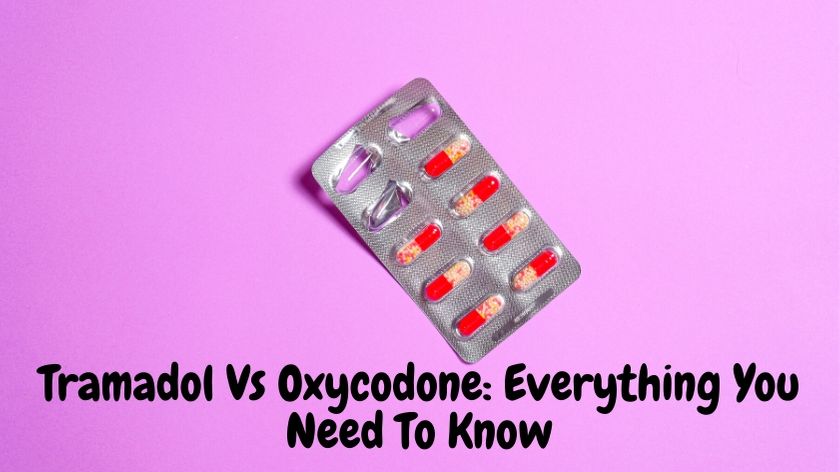Tramadol Vs Oxycodone: Everything You Need To Know

- The potency of the Medicines Compared with Morphine
- Forms of the Tablet
- How does the doctor determine the dosage of the medicine?
- Possible Side Effects of the Medicine
- Drug Interactions of the Medicine
- Conditions You Need to Inform Your Doctor About Before Starting on Tramadol or Oxycodone
- Possibility of Abuse of the Medicine
Tramadol and Oxycodone are both pain killer medicine prescribed by doctors for different injuries or health conditions. It is necessary to understand these medicines in greater detail before you can start using them for your ailments. Here we have tried to explain the different aspects of these two medicines so that all the queries are erased from the minds of the users. Read along to know:
The potency of the Medicines Compared with Morphine
Tramadol and Oxycodone are both pain-relieving medicines that belong to the category of opioid analgesics. These medicines work to change the way the brain responds to pain so that you gain pain relief. A doctor will always inform his patients about the way these medicines affect your body. However, if you wish to know more about the medicines and their possible side effects, you must read this article. We have explained all the facts related to these two pain-relieving medicines. Oxycodone is usually extended-release tablets that are prescribed to patients who need continuous relief from pain.
Forms of the Tablet
Tramadol medicine is available in many different brand names like Ultram, Ultram ER, and Conzip. Oxycodone is available in brand names Roxicodone and Oxaydo. Oxycodone Cr is available by the brand name Oxycontin. These tablets are also available in many different strengths. Tramadol immediate-release tablet is available in 50mg strength. Extended-release Tramadol tablets are available in 100mg, 200mg, and 300mg formats. Extended-release oral capsules are available in 100mg, 150mg, 200mg and 300mg strengths. Oxycodone immediate-release oral tablets are available in 5mg, 10mg, 15mg, 20mg and 30mg strengths. Oxycodone controlled release oral tablets are available in 10mg, 15mg, 20mg, 30mg, 40mg, 60mg and 80mg strengths.
Also Read: How To Buy Tramadol Online Safely?
How does the doctor determine the dosage of the medicine?
The right dosage of the medicine should be decided by the doctor. There are many factors that the doctor may consider before prescribing the medicine to you.
Here we have listed out the major factors that the doctors may consider while prescribing Tramadol or Oxycodone medicines to you for pain relief:
- The doctor may prescribe Tramadol medicine for chronic pain issues and Oxycodone for prolonged or continuous pain issues.
- The doctor may check your medical history and the possibility of drug abuse before prescribing these medicines. This is because the medicines could be habit-forming in nature.
- The doctor may also check the medicines you are having to see whether Oxycodone or Tramadol has any drug interactions with these medicines. He will prescribe the medicine only if he is sure the medicine is safe for use.
- The medicine may not be prescribed to people with a history of respiratory health problems.
- The medicine won’t be prescribed to people who have kidney or liver health issues.
- A user should follow the prescription exactly and should not alter the dosage of the medicine without consulting the doctor.
Possible Side Effects of the Medicine
A user of pain relief medicines like Tramadol or Oxycodone should be aware of the possible side effects these medicines can cause.
Here we have shared an elaborate list of common side effects of both medicines as well as certain side effects specific side effects for each of these medicines. Read along and stay better informed:
- Tramadol and Oxycodone both cause nausea, vomiting, constipation, and similar other digestive health problems.
- Headache, dizziness, and drowsiness are other common side effects of Tramadol and Oxycodone.
- Bother these medicines can impact overall strength and cause weakness as well as overall lack of strength.
- Individuals are under the course of these medicines may also experience dry mouth and itching.
- Nervousness and indigestion are side effects peculiar to Tramadol medicine.
- Among the serious side effects of these medicines is slow breathing.
- Tramadol may also cause seizures and serotonin syndrome as side effects.
- Oxycodone may cause shock, low blood pressure, and cardiac arrest among serious side effects.
- Itching, hives, and swelling of the face are common side effects for Tramadol as well as Oxycodone.
- Narrowing of the airway and facing difficulty in breathing are the other possibilities.
Drug Interactions of the Medicine
It is important to understand the different drug interactions of Tramadol and Oxycodone before starting to use these medicines.
Here we have listed out the different drug interactions of these two medicines:
- Tramadol and Oxycodone may interact with other pain medications like morphine, fentanyl, and hydrocodone.
- Tramadol and Oxycodone also interact with drugs like Phenothiazines used to treat mental disorders.
- Oxycodone and Tramadol interact with sleeping pills like temazepam and zolpidem.
- These medicines also interact with tranquilizers like alprazolam and diazepam.
- Monoamine oxidase may also interact with Tramadol and Oxycodone.
- Tramadol is also known to interact with Ketoconazole, Quinidine, Erythromycin, Amitriptyline, and Triptans.
- Tramadol also interacts with Serotonin-norepinephrine reuptake inhibitors (SNRI) and Selective serotonin reuptake inhibitors (SSRI).
- Oxycodone medicine interacts with Butorphanol, Pentazocine, Nalbuphine, Buprenorphine, and different skeletal muscle relaxants like cyclobenzaprine.
- Tramadol may also interact with the action of natural nootropics like St. John’s Wort.
Conditions You Need to Inform Your Doctor About Before Starting on Tramadol or Oxycodone
A doctor should have an honest view of your health condition so that he can make a well-informed decision regarding the medicine and its dosage.
Here are some health conditions you should tell your doctor about:
- Before starting on a dose of oxycodone or Tramadol, inform your doctor about respiratory conditions like a chronic obstructive pulmonary disease.
- You also need to inform your doctor about metabolic disorders before starting on a course of Tramadol medicine.
- Tramadol should not be prescribed to patients with a history of epilepsy, alcohol abuse, suicidal thoughts or attempts, kidney problems, or liver problems.
- Oxycodone should not be prescribed to people with pancreatic disease, head injuries, biliary tract disease, and low blood pressure issues.
Possibility of Abuse of the Medicine
Both Tramadol and Oxycodone are habit-forming medicines and so need to be administered carefully. The doctors usually start with small dosages and increase the dose gradually. The medicine should be consumed as per the doctor’s prescription and should not be altered without consulting the doctors.
March 14, 2020 Sam Bell











Comments